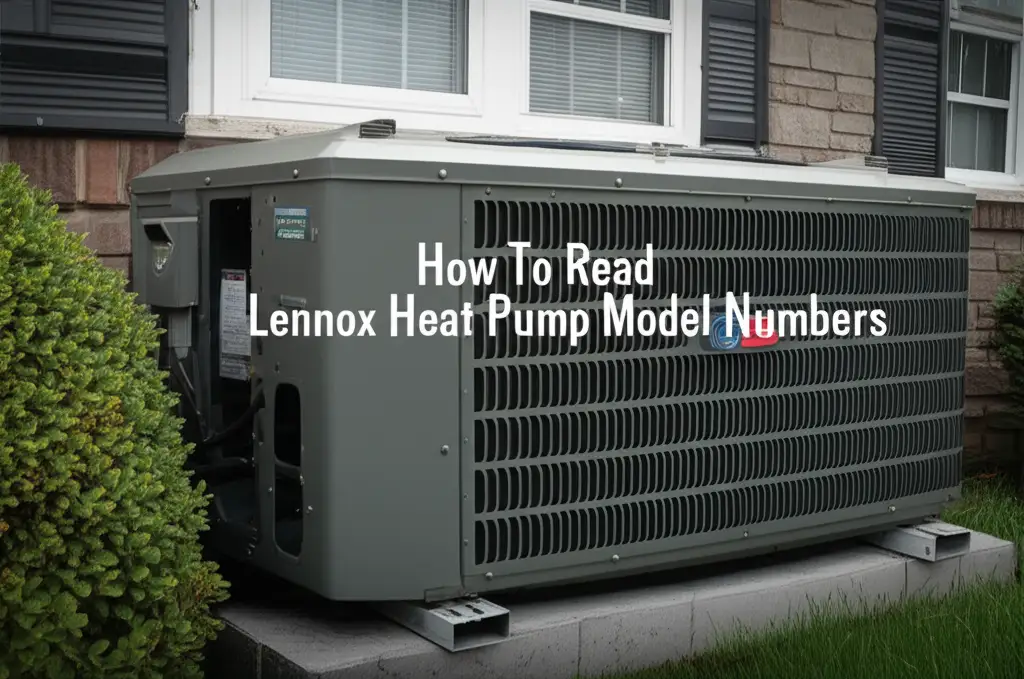· Todd Martin · HVAC · 12 min read
How To Read Lennox Heat Pump Model Numbers

Decode Your Lennox Heat Pump Model Number
Have you ever looked at the long string of letters and numbers on your Lennox heat pump and wondered what it all means? It looks like a secret code, right? Decoding these model numbers is not hard. Each part of the model number tells you something important about your heat pump. Knowing this information helps with maintenance, repair, and finding the right parts.
This guide will show you how to read Lennox heat pump model numbers. We will break down each section of the model number for you. You will learn about the series, capacity, efficiency ratings, and other key features. Understanding these details makes you a more informed homeowner. Let’s get started on understanding your Lennox heat pump.
Takeaway
- Locate the model number: Find the data plate on your outdoor or indoor unit.
- Understand the structure: Lennox model numbers follow a specific pattern, grouping information.
- Identify key segments: Learn what sections show series, capacity, and efficiency.
- Use the information: This knowledge helps with maintenance, repairs, and part replacement.
Main Query Answer
Reading Lennox heat pump model numbers helps you understand your unit’s specific type, heating and cooling capacity, efficiency ratings (like SEER and HSPF), and specific features. Each segment of the alphanumeric code provides a piece of information crucial for accurate service, part identification, and performance understanding.
Find Your Lennox Heat Pump Model Number
The first step to understanding your heat pump is finding its model number. Manufacturers place this information on a specific label. This label is often called a data plate or rating plate. Do not confuse the model number with the serial number. The serial number identifies your specific unit. The model number identifies the product line and features.
Lennox heat pumps have two main parts: an outdoor unit and an indoor unit. Both units have their own model numbers. The outdoor unit is often called a condenser or heat pump unit. The indoor unit is usually an air handler or furnace. You will find the data plate on the side or back of the outdoor unit. For the indoor unit, check the cabinet or inside the access panel. It is usually a silver or white sticker. Write down both model numbers once you find them.
The Structure of Lennox Model Numbers
Lennox uses a systematic approach for its model numbers. They combine letters and numbers to form a unique identifier. This system packs a lot of information into a short string. Each position or group of characters tells you something specific. We can break down the full number into smaller parts.
Imagine the model number as a series of different codes. One part tells you the product family. Another part reveals the capacity. A different part shows the efficiency. Learning this structure makes decoding simple. Understanding the overall layout helps you find the specific data you need quickly. This knowledge simplifies interactions with technicians or when buying parts. For example, reading Goodman heat pump model numbers or Trane air conditioner model numbers also follows a similar idea of breaking down codes.
A typical Lennox model number might look like “XP21-036-230-01”. Each segment means something.
- XP21: This identifies the product line or series. XP often means a heat pump. The number after it relates to efficiency or generation.
- 036: This indicates the capacity in BTUs (British Thermal Units). We will discuss this more soon.
- 230: This often relates to the voltage requirement.
- 01: This might be a revision number or other minor detail.
Knowing this general pattern helps you begin your decoding process. You can then look closely at each part.
Decoding Capacity and Tonnage
One of the most important pieces of information in a Lennox heat pump model number is its capacity. Capacity refers to the unit’s heating and cooling power. It is measured in British Thermal Units per hour (BTUh) or tons. One ton of cooling equals 12,000 BTUh. Heat pumps are rated by how much heat they can move in an hour.
You will usually find the capacity expressed as a two or three-digit number. This number is often the second or third segment in the model number. For example, if you see “036” in your model number, it means 36,000 BTUh. To convert this to tons, you divide by 12,000. So, 36,000 BTUh is a 3-ton unit. Common capacities include 24 (2 tons), 30 (2.5 tons), 36 (3 tons), 42 (3.5 tons), 48 (4 tons), and 60 (5 tons).
Choosing the correct capacity is important for comfort and efficiency. A unit that is too small cannot cool or heat your home properly. A unit that is too large will cycle on and off too often. This wastes energy and wears out parts faster. Always ensure your heat pump matches your home’s needs. If your Lennox heat pump is not heating properly, the capacity might be a factor, or there could be other issues. (Why is my Lennox heat pump not heating?)
Interpreting Series and Efficiency Ratings
Lennox organizes its heat pumps into different series or product lines. These series often indicate the level of technology and efficiency. Understanding the series helps you know the general performance level of your unit. Common Lennox series include Merit, Elite, and Signature.
- Merit Series: This is Lennox’s entry-level series. Units in this series offer reliable performance and standard efficiency. They are a cost-effective choice for many homes. The model numbers might start with “13HP” or similar.
- Elite Series: This series offers enhanced efficiency and comfort features. These units often have higher SEER and HSPF ratings. Model numbers for Elite series heat pumps often begin with “XP17” or “XP20”. They provide a good balance of performance and value.
- Signature Collection: This is Lennox’s premium series. These units offer the highest efficiency ratings and advanced features. This includes variable-capacity operation and smart home compatibility. Model numbers for Signature Collection units often start with “XP21” or “SL25XP”. They represent top-tier energy savings and quiet operation.
Efficiency ratings are also embedded in the model number, often linked to the series designator. SEER (Seasonal Energy Efficiency Ratio) measures cooling efficiency. HSPF (Heating Seasonal Performance Factor) measures heating efficiency. Higher numbers mean greater efficiency and lower energy bills. For example, an “XP21” model number tells you it is a very high-efficiency unit, often with a SEER of 21 or higher. This helps you understand how well your unit operates and how much energy it uses. Knowing these details is helpful if your Lennox heat pump is blowing cold air, as lower efficiency units might struggle more in extreme temperatures. (Why is my Lennox heat pump blowing cold air?)
Identifying Key Features and Components
Beyond capacity and efficiency, Lennox model numbers can also hint at specific features. These features can include single-stage, two-stage, or variable-capacity operation. They can also indicate special components or design elements. These details affect the unit’s performance, comfort levels, and price point.
- Staging:
- Single-Stage: These units operate at full capacity when on. Their model numbers typically do not have special indicators for staging. They are simple and effective.
- Two-Stage: These units have two levels of heating or cooling output. They can run at a lower setting for mild conditions. This provides better humidity control and more consistent temperatures. The model number might have specific characters to indicate two-stage operation.
- Variable-Capacity: These are the most advanced units. They can precisely adjust their output to match your home’s needs. This leads to the highest efficiency and best comfort. Lennox’s Signature Collection models (e.g., SL25XP, XP21) usually offer variable capacity. Their model numbers directly reflect this premium technology.
- Communication Systems: Some modern Lennox units use proprietary communication systems. These systems allow the outdoor unit, indoor unit, and thermostat to work together seamlessly. This optimizes performance and allows for advanced diagnostics. Model numbers for these units might include specific designators. An example is the “i” in some model names, indicating iComfort compatibility.
- Special Designations: Sometimes, letters or numbers indicate specific design choices. This could be a specific type of compressor or a special coil design. These details are often more for technicians. However, knowing they exist helps you understand the complexity of the model number.
Understanding these feature indicators helps you appreciate the technology inside your heat pump. It also helps explain why different models have different prices and performance levels.
Pinpointing Manufacturing Details and Revisions
Lennox heat pump model numbers often contain clues about their manufacturing details. This can include the year of manufacture. It can also include revision numbers. Knowing the age of your unit helps you estimate its remaining lifespan. It also helps determine if it is still under warranty. Revision numbers are important for service technicians. They ensure the correct replacement parts are ordered.
The manufacturing date is usually found in the serial number. However, sometimes elements in the model number can provide a general idea of the product generation. For example, a model like “XP20” indicates a newer generation compared to an older “XP17” or “13HPX” model. While the model number itself does not directly state a date, it points to a design era.
Revision numbers are often the last two digits in a model number, like “-01” or “-02”. These numbers indicate minor changes or updates to the product design. These changes do not create a new model line. Instead, they represent improvements or modifications within the same model series. When ordering parts, a technician needs to know the exact revision. This ensures compatibility. Using the wrong part, even for the same model, can cause problems. Always provide the full model number, including any revision codes, to service professionals. This helps them diagnose issues correctly. It also ensures they bring the right tools and parts. This can save you time and money.
Why Decoding Model Numbers Helps You
Knowing how to read Lennox heat pump model numbers offers many benefits. It helps you become a more informed owner. This knowledge empowers you to make better decisions about your home’s heating and cooling.
First, accurate model identification is critical for maintenance and repairs. When you call a technician, providing the precise model number speeds up the process. They can look up diagrams, common issues, and required parts. This means less diagnostic time and a quicker fix. For example, if your heat pump keeps turning on and off, knowing the model number helps the technician troubleshoot more effectively. (Why does heat pump keep turning on and off?)
Second, understanding the capacity and efficiency ratings helps with energy management. You can compare your unit’s efficiency to newer models. This helps you decide if an upgrade makes sense for energy savings. It also confirms if your unit is correctly sized for your home. An undersized unit struggles, and an oversized unit wastes energy.
Third, knowing your model details is vital for warranty claims. Manufacturers base warranties on the specific model and serial number. Having this information ready streamlines any warranty service you might need. It proves you own the unit in question.
Finally, this knowledge helps with future planning and replacement. When it is time to replace your heat pump, understanding your current unit’s specifications is a starting point. You can discuss upgrades with confidence. You can ask for units with similar or better features based on your understanding of the codes. This helps you choose the best system for your home and budget.
FAQ Section
What is the difference between a model number and a serial number on a Lennox heat pump?
The model number identifies the specific product series, design, capacity, and features. It applies to all units of that type. The serial number, however, is unique to your specific unit. It is like a vehicle identification number (VIN). The serial number helps track manufacturing date and warranty information for your particular heat pump.
Where is the model number located on my Lennox outdoor unit?
You can find the model number on a data plate or sticker. This is typically on the side or back panel of the outdoor condenser unit. Sometimes it is inside an access panel. Always look for a clear, silver, or white sticker with black text.
Can I find my Lennox heat pump’s age from the model number?
The model number itself typically does not directly state the manufacturing date. However, the serial number, usually found near the model number, contains coded information about the manufacturing year and month. You often need a special chart or a call to Lennox support to decode the serial number for the exact date.
How do I know the cooling capacity (tons) from my Lennox model number?
Look for a two or three-digit number, often around the middle of the model number. This number represents the BTUh (British Thermal Units per hour) capacity. For example, “036” means 36,000 BTUh. To convert to tons, divide the BTUh by 12,000 (e.g., 36,000 BTUh / 12,000 = 3 tons).
Do Lennox indoor and outdoor units have the same model number?
No, the indoor and outdoor units (e.g., air handler/furnace and outdoor condenser) are separate components. Each component has its own unique model number. They are designed to work together, but they are distinct products. You should record both model numbers for service or parts needs.
Does a higher number in the Lennox model mean better efficiency?
Often, yes. For Lennox heat pumps, especially in series like “XP,” a higher number after “XP” generally indicates a higher SEER (Seasonal Energy Efficiency Ratio) or HSPF (Heating Seasonal Performance Factor) rating. For example, an XP21 is more efficient than an XP17. This is a common pattern across many manufacturers for efficiency identification.
Conclusion
Understanding your Lennox heat pump model number empowers you as a homeowner. We have seen how each segment of the model number provides crucial details. You now know how to identify the series, capacity, efficiency ratings, and specific features of your unit. This knowledge is not just for technicians. It is for you.
By decoding your Lennox heat pump model number, you gain valuable insights. You can speak confidently with service professionals. You can make informed decisions about maintenance, repairs, and future upgrades. This helps ensure your heat pump runs efficiently. It also helps it provide comfort for many years. Next time you see that string of characters, you will know exactly what story it tells about your home’s essential heating and cooling system. Use this guide to become an expert on your Lennox heat pump.





